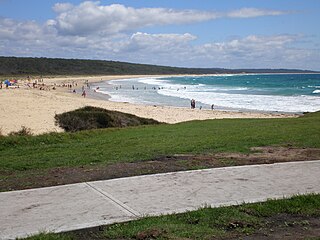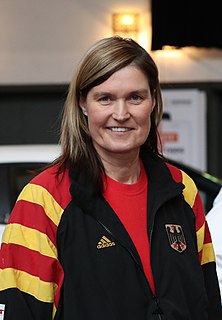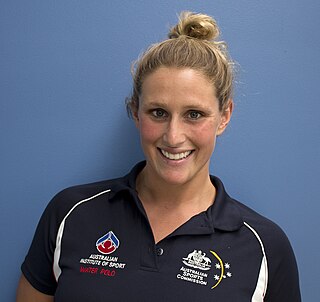| Country | Australia |
|---|---|
| Governing body | Sliding Sports Australia |
| National team | Australia |


Australia created a female team in the sport of skeleton in the hope of winning a medal at the 2006 Winter Olympics. Physiologists Dr David Martin and Dr Angus Ross looked at a list of winter sports. They regarded the women's division of the sport as not currently being strongly competitive, therefore athletes in non-winter sports who possess the traits that would make a good skeleton athlete could win a medal. [1]

Australia, officially the Commonwealth of Australia, is a sovereign country comprising the mainland of the Australian continent, the island of Tasmania and numerous smaller islands. It is the largest country in Oceania and the world's sixth-largest country by total area. The neighbouring countries are Papua New Guinea, Indonesia and East Timor to the north; the Solomon Islands and Vanuatu to the north-east; and New Zealand to the south-east. The population of 25 million is highly urbanised and heavily concentrated on the eastern seaboard. Australia's capital is Canberra, and its largest city is Sydney. The country's other major metropolitan areas are Melbourne, Brisbane, Perth and Adelaide.

Skeleton is a winter sliding sport in which a person rides a small sled, known as a skeleton bobsled, down a frozen track while lying face down and head-first. The sport and the sled may have been named from the bony appearance of the sled.

The 2006 Winter Olympics, officially known as the XX Olympic Winter Games and commonly known as Turin 2006 or Torino 2006, was a winter multi-sport event which was held in Turin, Piedmont, Italy from February 10 to 26, 2006. This marked the second time that Italy had hosted the Winter Olympic Games, the first being the 1956 Winter Olympics in Cortina d'Ampezzo. Italy also hosted the Summer Olympics in 1960 in Rome. Turin was selected as the host city for the 2006 Games in June 1999.
Contents
Almost 100 athletes from a variety of sports, including athletics and Surf lifesaving sports, were invited to be tested by the Australian Institute of Sport for their suitability in the sport.
The Australian Institute of Sport (AIS) is a sports training institution in Australia. The Institute's headquarters were opened in 1981 and are situated in Canberra. The 66-hectare site campus is in the northern suburb of Bruce. The AIS is a division of the Australian Sports Commission.
The tests included their ability to sprint over 30 metres, body type and attitude. Training included practicing starts using a skeleton sled with wheels underneath. 35 people were selected for a training camp, and 10 comprised a squad that competed in the sport internationally. [2]
The athletes tested their wind resistance in Monash University's wind tunnel to see which body positions would be the most aerodynamic. The university's aerodynamicist said that the testing enabled the athletes to reduce drag by between five and ten percent. [3]

Monash University is a public research university based in Melbourne, Australia. Founded in 1958, it is the second oldest university in the State of Victoria. The university has a number of campuses, four of which are in Victoria, and one in Malaysia. Monash also has a research and teaching centre in Prato, Italy, a graduate research school in Mumbai, India and a graduate school in Suzhou, China. Monash University courses are also delivered at other locations, including South Africa.

A wind tunnel is a tool used in aerodynamic research to study the effects of air moving past solid objects. A wind tunnel consists of a tubular passage with the object under test mounted in the middle. Air is made to move past the object by a powerful fan system or other means. The test object, often called a wind tunnel model, is instrumented with suitable sensors to measure aerodynamic forces, pressure distribution, or other aerodynamic-related characteristics.

Aerodynamics, from Greek ἀήρ aer (air) + δυναμική (dynamics), is the study of motion of air, particularly as interaction with a solid object, such as an airplane wing. It is a sub-field of fluid dynamics and gas dynamics, and many aspects of aerodynamics theory are common to these fields. The term aerodynamics is often used synonymously with gas dynamics, the difference being that "gas dynamics" applies to the study of the motion of all gases, and is not limited to air. The formal study of aerodynamics began in the modern sense in the eighteenth century, although observations of fundamental concepts such as aerodynamic drag were recorded much earlier. Most of the early efforts in aerodynamics were directed toward achieving heavier-than-air flight, which was first demonstrated by Otto Lilienthal in 1891. Since then, the use of aerodynamics through mathematical analysis, empirical approximations, wind tunnel experimentation, and computer simulations has formed a rational basis for the development of heavier-than-air flight and a number of other technologies. Recent work in aerodynamics has focused on issues related to compressible flow, turbulence, and boundary layers and has become increasingly computational in nature.
Five athletes were selected for the shadow team.
- Shaun Boyle, born 30 January 1971. The only male athlete in the skeleton shadow team.
- Melissa Hoar, surf lifesaving sportswoman. Dalmeny resident.
- Bindee Johnston (formerly Bindee Goon Chew), 100m and 200m sprinter. Townsville resident.
- Emma Lincoln-Smith, surf lifesaving sportswoman.
- Michelle Steele, surf lifesaving sportswoman. Born 8 March 1986. Bundaberg resident.
Shaun Boyle is an Australian skeleton racer who competed from 2001 to 2006. He finished 22nd in the men's skeleton event at the 2006 Winter Olympics in Turin.
Melissa Hoar is an Australian skeleton racer who has competed since 2004. Her best Skeleton World Cup finish was fifth at Nagano in January 2006.

Dalmeny is a town on the south coast of New South Wales, Australia, approximately seven kilometres north of Narooma. At the 2011 census, Dalmeny had a population of 1,932 people.
Michelle Steele was selected for Australia's women's slot after time trials in Königssee, Germany. [4] She came 13th at the 2006 Winter Olympics. Boyle also competed at the 2006 Games, finishing 22nd in the men's event. [5]

The Königssee is a natural lake in the extreme southeast Berchtesgadener Land district of the German state of Bavaria, near the Austrian border. Most of the lake is within the Berchtesgaden National Park.

Germany, officially the Federal Republic of Germany, is a country in Central and Western Europe, lying between the Baltic and North Seas to the north, and the Alps to the south. It borders Denmark to the north, Poland and the Czech Republic to the east, Austria and Switzerland to the south, France to the southwest, and Luxembourg, Belgium and the Netherlands to the west.
Another recruitment drive occurred in mid-2006. Candidates will be assessed on spatial and body awareness, useful in driving a sled, as well as sprinting ability. Ten candidates will attend a training camp, and up to five will join Steele, Lincoln-Smith and Hoar in the national squad. [6]
Three Australian sliders competed at the 2010 Winter Olympics in Vancouver: Anthony Deane, who finished in 23rd place in the men's competition, Lincoln-Smith, who placed 10th in the women's event, and Hoar, who finished 12th in the women's event. The best results for Australians in top-flight skeleton competition as of mid-2013 were Steele's sixth place at the FIBT World Championships 2013 and second places for Lincoln-Smith and Lucy Chaffer during the 2011–12 Skeleton World Cup. [7]












